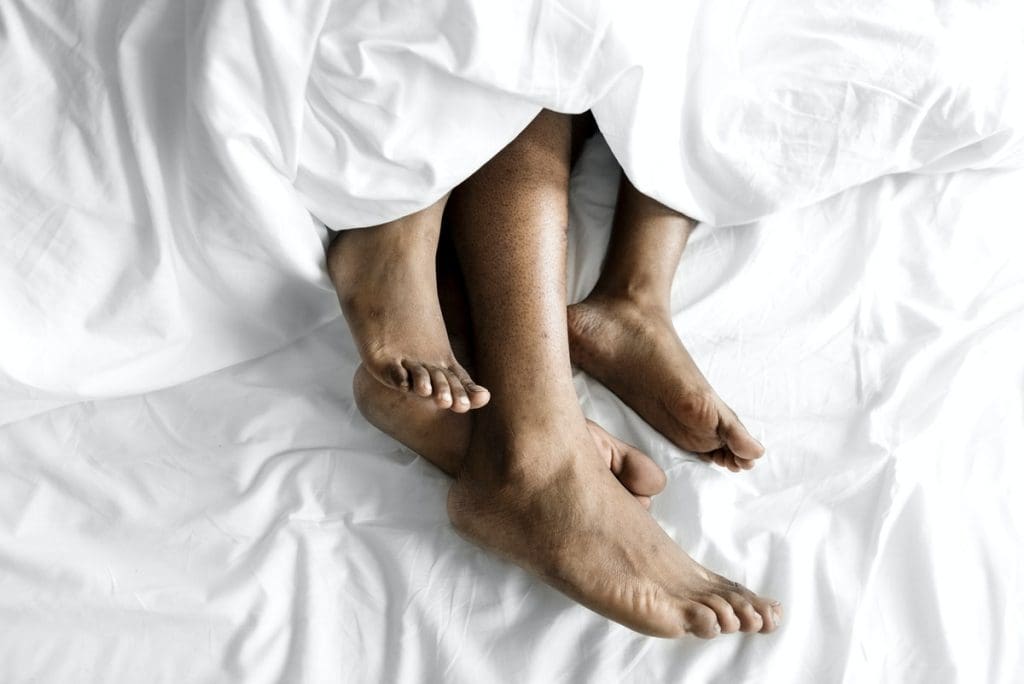Couple sleeping positions have been a source of confusion since the idea of intimacy came into the picture. In traditional Western society, we are accustomed to sleeping on our sides with one partner on top while the other lies on the floor or under a blanket. In Eastern cultures, however, we are taught that true intimacy is experienced when one person lies on top of the other with their eyes closed. There is some truth to this position, as long as it is done safely. It also requires two people who are comfortable with each other.
Table of Contents
Lying On Back With Legs Bent
The most common couple’s sleeping positions involve one person lying on their back with their legs bent comfortably. If you’re unsure about this one, be sure to sit up straight in a chair and keep your feet at least two feet apart. Now put one leg on top of the other, making sure that it’s firm and rests on the bed. Make sure that both of your feet are firm against the bed as well. This position will help you fall asleep easier. Just don’t try to pull yourself away from the bed if you think you can’t sleep in this position.
Love Spoon Position
The next couples’ sleeping positions are somewhat controversial, as some people do not like them and some couples enjoy them. However, the love spoon position is an excellent option for those who are uncomfortable with one person lying on top of the other. This position allows for better eye contact and greater intimacy. Many people who have never tried spoon love positions feel a bit claustrophobic at first, but they soon become accustomed to the slight discomforts. With a little bit of practice, this couple’s sleeping positions become very easy and sensual.

In this couple’s sleeping or cuddling position, two sleepers are put side by side with their heads touching. Their arms are also placed across their chests so that they form a single line. Two people can enjoy this amazing sleeping position. However, it is not recommended for those who like to keep their legs uncrossed. Because the sleeper’s legs are folded over their chest, it can be difficult to get them back into the original position when they awaken. A great way to deal with this issue is to use a tiny strip of rope or an elastic band to make the legs “come back” into position. This ensures that the sleeper’s legs are where they should be and provides additional reassurance that they will not fall out of the sleeping position.
Sleeping Tangle
The sleeping tangle is commonly referred to as the pillow over the head, which is perfect for those who like a good night’s sleep but don’t like waking up with their neck bent over their partner’s back. The “tangle” is formed by the loop of a thin piece of fabric tied around the top part of the sleeper’s head, providing support while they sleep. Sleeping with a tangle in place can provide a great deal of peace and relaxation for both people in the relationship. Still, it is important to remember that this particular sleeping arrangement does not last forever.

Leg Hugging
Leg Hugging is very similar to the previous option, but it requires slightly more caution. In Leg Hugging, one person snuggles up against the other’s body and holds on to each other’s ankles with one arm while the other persons’ legs are placed between their legs, forming a full-body hug. This position provides the dual advantage of providing comfort and encouraging independence. However, there is an element of danger involved in this type of sleeping arrangement. This is why it is typically used in a relationship where one person has greater emotional control.
Stomach Sleeper
The final sleeping arrangement we will discuss is the stomach sleeper. In the stomach sleeper, one person sleeps on the stomach while the other rests on their back, holding onto the other person’s waist and covering themselves with heavy blankets. Some couples choose this arrangement when both people have different preferences for what kind of sleep arrangement feels best. For example, some people may prefer to sleep on their stomachs, while others may prefer to sleep on their sides.
Each of these three options has many advantages and disadvantages. For example, if one person wants to have a romantic relationship, then the stomach sleeper might be the best choice. However, if independence is desired, a stand-alone pillow or a firm mattress could be used. A couple that works together well is always a good combination. On the other hand, if one person needs to rely on their partner for support, the side sleeper might provide them enough comfort. No matter how you decide to sleep, there are several options for couples who need a place to get the most out of their sleeping time.
Conclusion
On the subject of the couple sleeping positions and what they mean, spoon sleeping is probably one of the most recognizable sleeping positions that most couples ever sleep in. It’s simply where one partner positions the other in a cuddly way. In a cuddle-type position, the large spoon is atop the smaller spoon, and the small spoon is atop the large spoon. The large spoon’s legs are tucked under the small spoon’s legs, creating four legs that create a loop shape for the lower body of the sleeper. Because of this unique design and its comfort, many people choose to use this sleeping position throughout their relationship.
Although it is common for people to assume that this particular couple’s sleeping position is extremely safe, many experts are not so sure. The main concern is that it may leave one person very much exposed to the risks of snoring because of the unique loop design. This happens when the arms are pulled back, often to the side, and the body is angled forward towards the center of gravity. If these factors are not controlled or avoided, it may result in various health issues, including but not limited to heartburn and acid reflux. In addition, there are times when one person can fall backward from this position and tumble on the floor, requiring extra care when getting out of bed to avoid injury.
Featured Photo by Anastasia Shuraeva from Pexels




